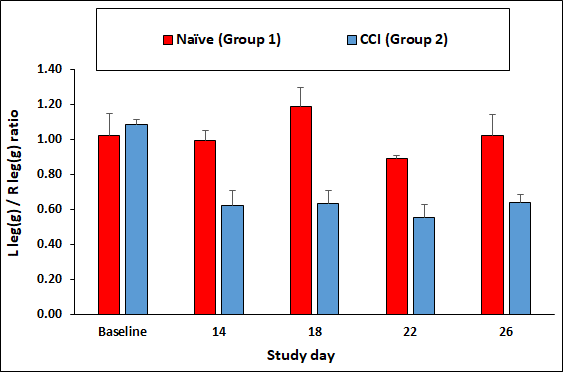4 min read
Assessing and measuring pain behaviors in preclinical studies
By: MD Biosciences on Jun 22, 2021 10:11:53 AM

Pain plays an important role in human life acting as a defense mechanism that protects us from harm. When pain becomes continuous or uncontrolled, it can negatively impact our immune system, lower our body’s ability to respond to stressful situations, or prevent healing when pain from tissue injury is not relieved. Unrelieved pain due to nerve damage can cause changes in the nervous system contributing to chronic or persistent pain long after the damage to the nerve is healed. Chronic pain doesn’t serve a protective purpose and can be a debilitating condition that is difficult to treat.
Chronic pain is among the most common chronic conditions impacting 1 in 5 adults in the US(1). The currently approved analgesics often lack efficacy and may have adverse dose-limiting effects leading researchers to prioritize the understanding of pain mechanisms to aid in the development of new treatments.
The pain of measuring pain.
In humans, measuring pain is commonly done through oral reports and pain scales. The challenge is that humans all experience pain differently and the report of pain sensations is subjective involving psychological, behavioral, emotional, cognitive, and sensory dimensions.
Measuring the intensity of pain is of high importance to both researchers and physicians since the measurement is essential to treatment and methods of control. In humans, pain can be distinguished by stimulus-evoked and spontaneous pain. In the clinic, the use of quantitative sensory testing, although not routine, may improve outcomes.
If only they could talk...
As researchers continue to evaluate effective treatments for pain, they rely on preclinical models using rodents and pigs, which have added challenges to measuring pain. Unlike humans, we are unable to directly measure pain through verbal descriptions, requiring the quantification of “pain-like” behaviors, or nociception, that are considered equivalent to humans. Pain tests in research are performed by using stimulus-evoked tests as well as methods to assess spontaneous pain. Since animals are unable to report pain, the response to stimulus does not necessarily mean they are experiencing pain. This requires researchers to rely on indirect methods to quantify and evaluate pain-like behaviors, which are reliable, reproducible, sensitive, and specific(2).
Since pain involves multiple dimensions, a variety of assessments and measurements are used to assess learning and cognition, anxiety and stress, sensory and motor function, balance and coordination as well as nociception.
Measuring stimulus-evoked pain behaviors in animal models of pain
Two of the most frequently used assays for studying hyperalgesia and allodynia are Von Frey and thermal tests.
Von Frey
The Von Frey test quantitatively measures tactile sensitivity using mechanical stimuli from hair-like filaments. Whether using manual Von Frey or electronic Von Frey, the test is an important measurement in pain research as a measurement of mechanical allodynia.
Tail flick or hot plate
The tail flick test involves the application of heat stimulus to the tail and recording the time it takes to flick or twitch the tail. The latency time measures the nociceptive sensitivity and can be prolonged using analgesics. It is a relatively easy and quick test to perform, making it commonly used in pain research. Since a spinal transection above the lumbar level does not block the tail flick response, it is useful for spinal nociceptive reflex rather than a direct measurement of pain. Similarly to the tail flick, the hot plate test measures the latency time for paw withdrawal after applied heat. One challenge with the hot plate test is variability due to learned behavioral responses from the rodents.
Measuring spontaneous pain in animal models of pain
Weight bearing tests are commonly used to measure spontaneous nociception in animals. Static weight bearing tests measure the distribution of weight across the hind paws where the pressure on the hind paws are measured using independent pressure sensors. Unequal distribution between the ipsilateral and contralateral paw are recorded and used as an indication of the nociception experienced. A few challenges are presented with the static weight bearing test in that it requires the animal to assume the correct stance and it can only be used in models with unilateral paw nociception.
MD Biosciences uses the dynamic weight bearing (DWB) test to measure weight bearing on all four paws as well as the weight ratio and paw surface in freely moving animals. Since altered weight bearing is a major symptom of human pain conditions, the dynamic weight bearing test may provide improved translation to the clinical situation.

Data: Dynamic weight bearing in the CCI model reflects the weight ratio between the left and right paws.
Summary
For drug developers, aligning rodent models with clinically relevant forms of pain is of prime importance in developing new treatments. There isn’t a single behavioral assay that can capture the full spectrum of nociception in non-verbal subjects. Therefore, studies should be optimized to include a combination of behavior assessments that are stimulus-dependent and spontaneous to characterize pain-like behaviors. MD Biosciences has extensive experience in designing pain studies that will combine the most relevant behavior tests based on the injury or disease.
-
Prevalence of chronic pain among adults in the United States. (2021) Journal for the International Study of Pain
-
Animal models of pain: progress and challenges. Mogil JS, Nat Rev Neurosci. 2009 Apr; 10(4):283-94.
Related Posts
Assessing Subjective Pain | Preclinical Pain Studies
Rodent models of pain such as nerve injury models are important to understand the mechanisms that...
The Critical Role of Clinical Relevance in Effective Study Design
Enhancing clinical relevance in early-stage studies can improve efficiency, reduce costs, and...
Preclinical Pig Models for Therapeutic Studies
Historically, rodent models have been used for the discovery of various biological mechanisms...


